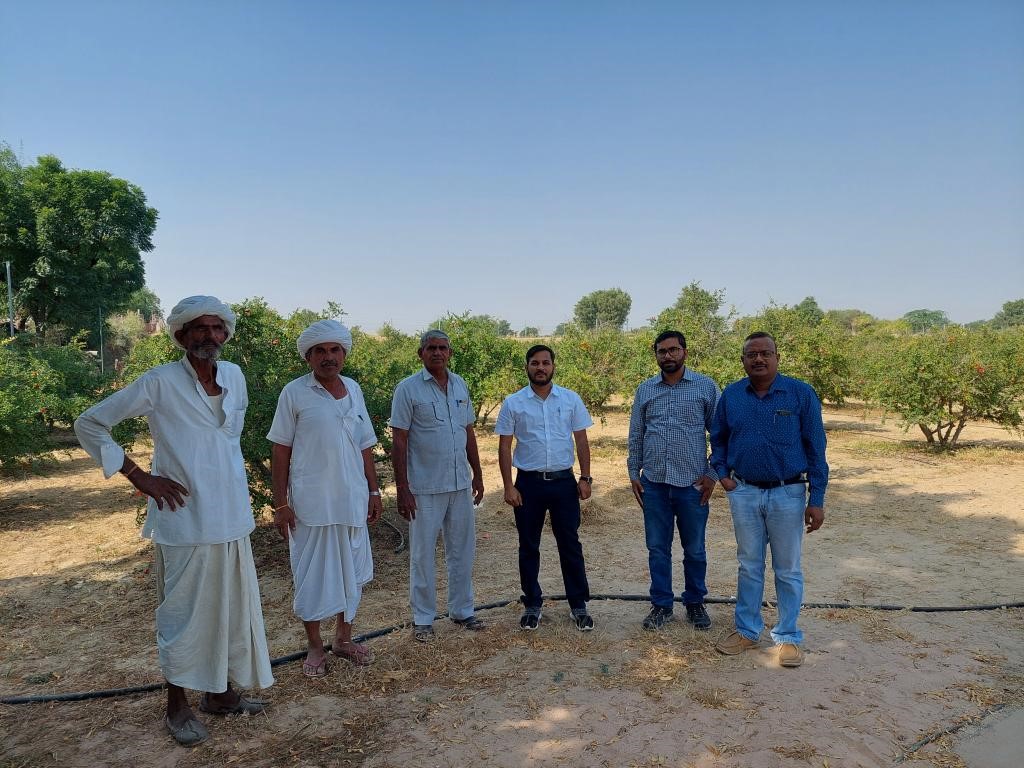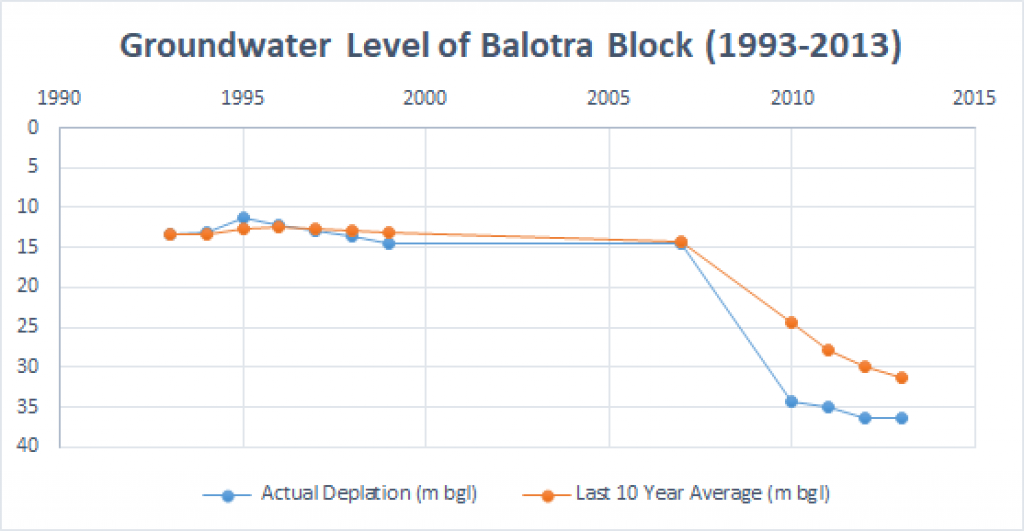Groundwater in Jagsa village, Barmer was depleting; now the thriving village is known for pomegranate farming

Jagsa village in Rajasthan’s Barmer district is an excellent example of how a village receiving just 284 millimetres of rainfall in a year can manage its water sources. The village that was once struggling for even drinking water is now thriving with pomegranate farms.
Huge dependence on groundwater tremendously depleted the water table of Balotra block in Barmer after 2007. It dropped to a depth of 34.77 metres below ground level in 2010.

Chart: Vivek Kumar Sah / CSE
The village economy depended only on agriculture and farmers’ incomes reduced from Rs 1.6 lakh per hectare in a year in the early 2000s to Rs 90,000 annually in 2010. The farmers started migrating to neighbouring Maharashtra to find work as labourers.
“Apart from agriculture, even getting drinking water was challenging in the village, with no surface or groundwater source. Villagers were dependent on tanker supply from nearby Balotra town for drinking water,” said Vivek Gupta, executive engineer from Rajasthan government’s Watershed and Soil Conservation Department.
Balotra is nearly 20 kilometres away and each water tanker cost the villagers Rs 2,000-3,000, which lasted a family of four-five a month. However, in the summers, the requirement went up to two-three tankers, costing them Rs 6,000-9,000 every month, Gupta added.
More than 20 villages in the block were facing the same issue. The Watershed and Soil Conservation Department took up the initiative to address these issues.
The Integrated Watershed Management Plan (IWMP)-16 was sanctioned in the year 2009-10. The department decided to construct 45,000-litre tanks for a few farmers along with rooftop rainwater harvesting structures in their house premises under the IWMP.
The rainwater harvested was mainly for drinking and irrigation of fields. There was also a provision for constructing tanks in farms of 100,000-litre capacity with Agor — a sloping surface platform or a tank’s water catchment area from where rainwater is collected.
The department officials conducted a village transect walk with the residents to find feasible locations for constructing tanks in the village. A village watershed committee was formed to operate and maintain the structures regularly.
A detailed project report was prepared with the help of villagers, which the state-level committee verified. Construction of a tank of 45,000-litre capacity costs around Rs 1-1.10 lakh and 100,000 litre costs Rs 1.5-1.75 lakh.
IWMP and Mahatma Gandhi National Rural Employment Guarantee Scheme funds were used for its operation and maintenance.
The rooftop rainwater harvesting structure helps the beneficiary to collect rainwater in the tank. The collected water is used for drinking for the whole year and is also cleaner compared to groundwater.

A tank with Agor in Jagsa village. Photo: Vivek Kumar Sah / CSE
The construction of the tank reduced the dependency on tankers and groundwater for the beneficiary. Households of four-five people who earlier depended on tankers could save up to Rs 8,000-10,000 per month and get water at their home premises. Villagers used the other tank in the farmland for irrigation.
The National Agriculture Development Scheme was launched in the year 2007. In 2010-11, the state government’s horticulture department started a fruit production scheme.
Only 16 farmers showed interest in it and in 2011, they began cultivating pomegranates on 32 hectares of farmland using water from the watershed tank scheme.
The model was very successful; today, more than 1,125 farmers are cultivating pomegranates on 3,200-3,300 hectares across the Balotra block.
Departments like horticulture promoted drip irrigation, which helped the farmers save water and time. Tapping rainwater helps the villagers a lot as it is more sustainable regarding water conservation and irrigation.
Today, farmers are getting an average yield of Rs 5 Lakh per hectare per annum.
Anchala Ram Ranchod Ram of Village Jagsa was one of the beneficiaries who joined the scheme in 2012. “Earlier, my family used to get drinking water from a tanker, which cost Rs 3,000 per month. Also, there was no reliable source to irrigate my farm land,” he said.
The construction of the rooftop harvesting structure and tank by the watershed department in 2012-2013 changed his life. “It helped my family get sufficient water for drinking throughout the year. Another tank on the farm helps me irrigate my fields for pomegranate cultivation,” Ram said.
His annual income has gone up from around Rs 1 lakh to Rs 5.5 lakh per annum.
In the village of Jagsa, more than 90 per cent of farmers follow the same pattern for drinking and irrigation. Farmers in the villages are moving towards pomegranate farming, helping them sustain their livelihood and reversing migration.
Many villages of the Balotra block, like Budiwada, are also following the same pattern.
“Through the increased income now, we can send our children for higher education to other states. Also, the money is being used in farm mechanisation, which makes farming easier and more remunerative,” said Ram.
Vardhman Envirotech
India’s Passionate rainwater company
This article is published on: Down To Earth, 24 March, 2023
We would like to spread this for the benefit of fellow Indians.
